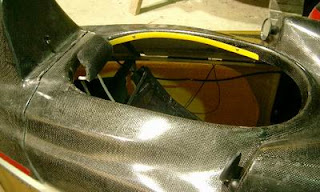I have started to build a new door for my Borealis. The present door was an experiment using some new material that didn't quite work out as well as it should. The door ended up warping quite a bit. It doesn't close properly and is heavier than need be. Hence the new new light weight carbon/kevlar version coming up. First we gel the mould and once that is hard the material is added to the mould. In the picture below you can see the first layer of carbon stuck to the gelcoat with the carbon,glass and kevlar reinforcing added.
This next picture shows all the material in but the last layer of peel ply which is partially installed. The Kevlar has been stopped just short of the edges and replaced with some carbon. The reason is that it very difficult to sand an edge with Kevlar smooth. Kevlar sands very poorly leaving a fuzzy edge.
Here is the next picture in the process with the bag sealed and a vacuum check being done. The bag is not polyethylene as it doesn't work very well for this process. Polyethylene expands somewhat when the resin exotherms, which can cause some problems for the part. The last thing you want to happen before the part has hardened is for the part to expand due a loss in vacuum because of a leak or pump failure. What happens is the part expands and fills with air. In the worst case it gets a third thicker and is a rather expensive spong like thing to throw away. Polyethylene also allows styrene vapours through it so you still have to wear a respirator making the whole process more unpleasant. We use a nylon bag which adds a bit to the cost but makes for a much more reasonable work environment.









